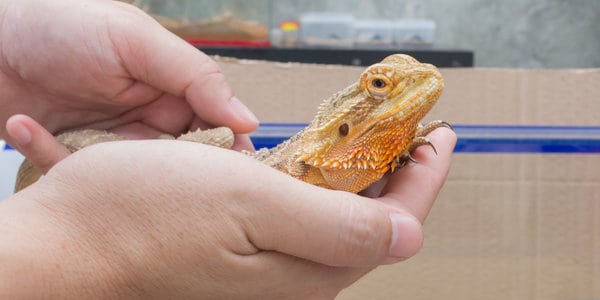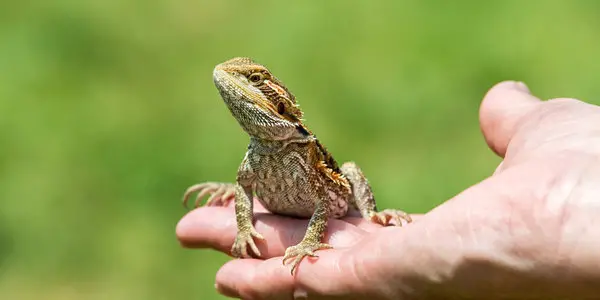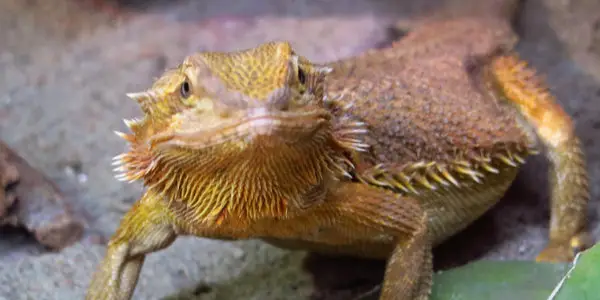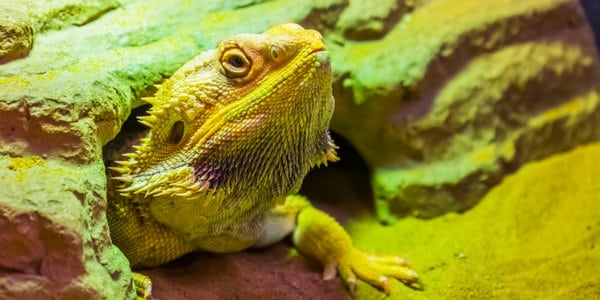Many pet beardie owners wonder about bearded dragon lifespan and how they can tell the age of their favorite bearded dragon, as it’s hard to estimate the age accurately.
There are a few biological and physical markers that you can rely upon to estimate the age of a beardie depending on whether it lived in the wild or captivity.
This is because pet beardies experience a significantly safer and healthier environment, unlike those who live in the wild.
Often the lifestyle gap leads to significant lifespan differences in the two groups, as we shall cover in this guide:
How Long Do Pet Bearded Dragons Live in Captivity?
Pet bearded dragons have a significantly longer lifespan in captivity than in the wild, and under the proper diet and living conditions, they can live for as long as 10 to 15 years.
The consistent supply of basic needs such as warmth, adequate humidity, a healthy diet, and protection from predators allows beardies to live a long and healthy life.
Here are some of the basic care needs for a healthy pet bearded dragon:
1. Proper Diet
Pet beardies need an omnivorous diet with vegetables and feeder insects in a 70% ratio to 30% greens. These ratios flip over time, and adult bearded dragons consume 70% greens with fewer meals, around 5 per week.
This is because they usually require more proteins to grow their bodies during their growth phase, and in maturity, they need more vitamins from plant matter to stay healthy. Bearded dragons can remain healthy and experience fewer diseases with the proper diet.
2. Safe Habitat
Your pet bearded dragon will require a safe habitat with plenty of space to house them. A 100 gallon provides enough living space for a grown beardie.
The enclosure should include a separate basking rock. Keeping your pet beardie in a comfortable enclosure will prevent glass surfing as the beardie feels free to roam around.
3. Health Complications
Pet beardies can develop health complications that you can resolve with proper veterinary care. You should always be on the lookout for any signs of health issues or illnesses that might drastically affect your beardie’s lifespan.
Health issues among bearded dragons and their symptoms include
- Metabolic bone disease: swollen face with lethargic limbs and twitching muscles.
- Obesity: thick tail base with a distended abdomen and jowls.
- Malnutrition: cloudy sunken eyes, black spots in the mouth, reduced movements, and runny stool.
- Parasites: diarrhea, reduced appetite, mucous or blood in feces, and dehydration.
- Impaction: inability to excrete, leg trembles, regurgitation, and dragging limbs.
Here is an article by VCA about bearded dragon diseases.
4. Safety
Pet bearded dragons are pretty docile and rarely stand a chance when attacked by predators, so you must provide a safe environment. Watch out for natural predators and other pets who might consider your beardie their next meal.
Bearded dragons prefer to stay alone in the enclosure, so if you have more of them, you will need individual setups for each beardie. This minimizes the occurrence of injuries arising from territorial fights.

How Long Does a Bearded Dragon Live in The Wild?
In the wild bearded dragons can live for up to five years, with some species living longer. However, the harsh conditions of the native desert habitats prevent many of them from living beyond two years or less.
Here are the main reasons why bearded dragons that live in the wild are shorter than in captivity:
1. Lack of Food
Bearded dragons have to compete with other wild animals for scarce food resources out in the wild, where they have to hunt for prey.
This process expands a lot of calories, and if not successful, the beardie may be too exhausted to evade predators on an empty stomach.
The scarcity means that meals are irregular and far apart. When the bearded dragon comes across just about anything edible, they will consume it, exposing them to parasites and diseases.
2. Predators
The wild bearded dragons are pretty tame, making them a perfect target for bigger predators looking for their next meal.
Young beardies are particularly vulnerable to predators during the daytime when hunting for food. This constant predation significantly lowers the lifespan of wild beardies.
3. Weather
Bearded dragons are sensitive to abrupt temperature changes, and when the temperature reaches either extreme, their bodies cannot thermoregulate, which leaves them vulnerable to the elements.
Their cold-blooded bodies rely on external heat sources to warm up and digest their food which is not suitable in drastically changing weather out in the wild.
These weather fluctuations may have a lethal effect on the beardie’s health, shortening their lifespan.
4. Disease
In the wild, bearded dragons are exposed to diseases and health problems. They easily contract parasites and illnesses that go untreated in the wild.
As a result, most of them die of illnesses quickly or are left with stunted growth.

How to Tell the Age of a Bearded Dragon?
While it can be difficult to tell the exact age of a bearded dragon, especially if it’s fully grown, there are a few ways to get around this conundrum.
If the beardie is still in its first year of life, measuring its length can help predict how old it is. You can also find out if the bearded dragon is sexually active, or you can consult your vet or breeder to determine the sex of the beardie.
1. Measure the Beardie from The Tip of the Tail to The Head.
Measuring your beardie’s length can give you a rough estimate of its age by comparing the length to the average growth chart. This method is not always right as health conditions and environmental factors can influence the length of a bearded dragon besides its age.
| Bearded Dragon Age | Average Growth Chart |
| 24+ months (adult beardies) | 18- 24+ inches |
| 12 months | 16- 22 inches |
| 8 months | 13- 20 inches |
| 6 months (juvenile beardies) | 11- 18 inches |
| 4 months | 9- 12 inches |
| 3months | 8- 11 inches |
| 2 months | 5- 9 inches |
| 0- 1 months | 3- 4 inches |
2. Checking for Sexual Maturity
Healthy beardies achieve sexual maturity around the age of 8 to 12 months. This method is also rough on its estimates as there are health complications that might delay reproductive maturity in bearded dragons.
You should look for gender traits such as bulging near the base of the tail to determine if the beardie is sexually mature, which would indicate that they are at least one-year-old.
7 Factors Affecting The Lifespan Of Bearded Dragons
Both within and outside the owner’s control, there are factors that will impact how long your beardie may live. Here are the most common factors.
1. Sex
It’s not always the case, but male bearded dragons live longer than females. This is partially due to size differences, as males tend to be larger than females.
Although this isn’t a hard and fast rule, larger bearded dragons live much longer. Also, breeding impacts the lifespan of the female. Females without babies are likely to live longer than those without.
Reproduction takes a toll on their bodies, just like in people. The stress is likely to shorten the lifespan of most females. As such, the average lifespan of a female is shorter than male.
Note that we aren’t saying you shouldn’t get a female beardie, but you should be aware that breeding can impact their lifespan.
2. Genetics
Additionally, genes play a role in lifespan regardless of the species. Bearded dragons with healthy and hardy genes will help your dragon live longer. One of the best ways to ensure you pick a healthy dragon is to get yours from a reputable breeder.
You do not necessarily have to buy your bearded dragon from the big store because it’s not an assurance that the origin is legitimate. Most of these dragons have been raised in second-rate farms that favor profits instead of healthy genes.
A significant advantage of getting your beardie from a breeder is the reputation. Besides, most local breeders work on a small scale and can direct effort into fortifying genes via selective breeding.
Breeders focus on producing top-quality beardies and have a strong dragon gene pool. Purchasing from such breeders can increase your chances of picking the right, bearded dragon.
3. Diet
Like humans, the diet plays a massive role in a bearded dragon’s overall health. Bearded dragons that lack a well-balanced diet without the essential nutrients it needs for growth are likely to suffer from deficiencies and live a short life as a result.
On the other hand, dragons that feed a diverse diet that meets their needs will maintain proper health and might live much longer. Keep in mind that the nutrient ratio for bearded dragons changes with age.
For instance, juveniles should eat more insects and less plant-based food. When they reach adulthood, you should change it to 75% more plants compared to just 25% insects.
4. Environmental Conditions
A good bit of planning for the environment of your bearded dragon plays a key role. Because they are used to the dry and hot environment of Australia, you have to match the specific temperatures, light, and humidity. Meeting these needs keeps your beardie healthy, while increasing the dragon’s lifespan.
The tank needs to have two heat zones – one that’s hot and the other that should be cooler. The hot side of the enclosure should range from 96-110 degrees Fahrenheit, depending on the season and age of your dragon. The cooler side of the tank should range from 75-85 degrees. In addition, light bulbs are a must to provide the UVA and UVB they need.
Humidity levels need to remain under 40%, depending on the water placement in the enclosure. Sticking a hygrometer on the wall will help you keep an eye on the humidity in your beardie’s tank.
Also, consider the dragon’s substrate. Some like newspapers, bark, oak, and coconut husk work great. However, some like dust and other substrates with small particles can cause infections, impactions, and other health issues. A dragon that develops repeated health issues will likely have a shortened lifespan.
5. Healthcare
Bearded dragons develop health problems in the wild as well in captivity. While there are no vaccines needed for beardies, it shouldn’t be enough reason not to provide veterinary attention.
Beardies can benefit from physical examinations and vet checkups like all other pets. The feces should be checked for parasites to ensure there are no hidden illnesses that do not show any signs.
Metabolic bone disease is among the most common illnesses among bearded dragons. Although it’s non-infectious, the disease can progress to the spine, jaws, and front legs, causing them to splay.
The condition can result from husbandry mistakes like a lack of adequate UVB light and a lack of calcium supplements.
Regular vet checkups are one of those things most owners are lazy about at times. But trust us, it can prolong your beardie’s lifespan and isn’t even expensive.
6. Size of the Enclosure
The bearded dragons also need to live comfortably if you want them to stay longer. You need to have enough space to encourage movement and enough resources necessary to achieve a full lifespan.
While a 20-gallon enclosure will suffice for a bearded baby dragon, adults need at least 100 gallons if they have reached more than 20 inches long. This may take a great deal of space at your home, but this is what will keep your beardie healthy.
7. Species
There are at least eight known subspecies of bearded dragons. The larger species are hardy and more resilient than the smaller ones.
In the wild, the more giant bearded dragons are better at fending off predators and get used to the environment more easily.
Pogona vitticeps is one of the most common pet species, with a lifespan of up to 12 years. The Rankin’s dragon is a much smaller species that could live about seven years.

Life Stages and Life Cycle of a Bearded Dragon:
As your dragon ages, it will go through these stages:
1. Embryonic Stage.
After successful fertilization, the dragon enters the first stage of life development. The embryonic stage occurs within the egg. Whether the mother faces stress and the quality of nutrition she gets will determine the offspring’s quality of living.
2. Hatching Stage
Once the egg hatches, the young beardie is about 3 inches and will remain a hatchling until they achieve about 8 inches in about two months. During the hatchling stage, dragons will see up to 3 inches of growth in length per month.
3. Juvenile
Hatchlings move to the next stage when they reach 7-8 inches in length. These sub-adults grow for about an inch each month. The juvenile stage starts months into a year of age, where the dragon should feed about 75% insects and 25% plant matter like veg and fruit.
4. Young Adult
After a year, your beardie is now considered a young adult. At this stage, the growth stabilizes, and they do not grow as quickly. They are also nearing sexual maturity, which can be seen in their behavior. They should eat 50% plants and 50% insects at this age.
5. Mature Adult
The stage starts at four years when the dragon is fully grown. The mature adult should feed the opposite of a juvenile. He should be eating 75% plant matter and 25% insects.
6. Senior
The last stage is old age when your beardie reaches seven years. They start to move less, and the appetite decreases. Depending on how well the dragon has been raised, the effects of this stage may take longer to set in.
Well-cared dragons could stay strong until 15 years or older. On the other hand, poorly kept dragons may live on for only a few more years.
How To Increase Your Bearded Dragon’s Lifespan?
Bearded dragons have significantly few health complications, and with proper care, they have a long lifespan. The major influence on their lifespan is their genetic predisposition and environmental factors around where the beardie spends most of its days.
Here are a few factors within your control that can increase a bearded dragon’s lifespan.
1. Provide a Healthy Diet
Bearded dragons prefer an omnivorous diet with varying veggies and insect protein ratios depending on their age. This is due to their changing needs for calcium, protein, and vitamins as they age and their bodies stop growing so much in size.
Providing your pet beardie with a balanced diet will significantly boost their lifespan and reduce the occurrence of diet-related health compactions.
2. Use Safe Products
Beardies are sensitive to some common pet ingredients that one might make the mistake of using instead of beardie-safe products. The most common of these is the use of loose substrate sand and small gravels that beardies end up consuming, causing impaction.
Avoid purchasing feeder ants from breeders whose quality you cannot ascertain as they might contain harmful pesticides to your beardie.
You should not use soapy water for bathing your beardie as most soaps contain chemicals that can damage the beardie’s sensitive skin.
3. Consult Your Vet On Supplements.
As bearded dragons age, their digestive systems cannot always absorb all of the necessary nutrients from their daily meals, and they might need supplements. This is especially the case with vitamin D3 and calcium supplements that your vet might recommend for your beardie once they are fully mature.
4. Provide Adequate Hydration
Although bearded dragons evolved to survive the thrush desert conditions of their natural habitats in Australia, they require a fresh supply of clean water at all times. This will give them enough water to drink and even bathe for at least 20 minutes every day to boost their skin health and lifespan.
5. Minimize Stress Risks
Avoid raising beardies in stressful conditions that might impact their lifespan. This includes providing all necessary care and basic needs while removing any stressors from the enclosure. Avoid keeping other animals in the same enclosure as the beardie.
If you have other pets that are relatively noisy, you should consider moving them to a different room to prevent getting your pet beardie.
You can also put a cloth background on the side of the glass enclosure that might be reflecting light inside the enclosure to avoid glass surfing.
6. Avoid Over-Breeding
Constantly breeding female bearded dragons impacts their lifespan adieu to the physical starting on their organs.
The breeding process is also nutritionally demanding, which depletes essential nutrients such as vitamins and calcium from the mother, significantly reducing her life.
Consult your vet on how to avoid overbreeding your bearded dragon.
7. Get the Right Size Tank.
As bearded dragons grow, they will require more space in the tank to roam around stress-free. Baby bearded dragons require at least 20 gallons of tank size, and when they grow to ten to sixteen inches, you will need to get a 40-gallon tank.
Adult bearded dragons require around a 100-gallon tank to give them enough room to grow.
8. Get a Thermometer and a Hygrometer.
Bearded dragons are sensitive to temperature and humidity changes. Equip the enclosure with a thermometer to monitor the temperature, especially on the basking side of the enclosure, where temperatures should be around 90 to 93 degrees F.
The cooler side of the tank should average approximately 80 to 90 degrees during the day and 70 to 75 degrees F during the night.
Get two humidity gauges to keep a close watch over the relative humidity level in the enclosure so that it’s always between 30 to 40%. You can also get a humidifier if the air in the enclosure is too dry as the beardies need to shed properly.
High humidity will cause bacterial infection in the respiratory system and drive mold growth on the beardie’s skin, keeping the humidity within the optimal ranges.
9. Get Rid of Any Poisonous Food.
If you have any toxic foods in your house for bearded dragons, it’s advisable to throw them out to avoid accidental ingestion. These include buttercup, poppy, sweet pea, primrose, azalea, amaryllis, elderberry, and tulips.
If you must have these foods in your house, avoid handling the beardie after coming into contact with the poisonous food.
10. Bathe Your Beardie Regularly
Bathing your beardie regularly will keep the skin healthy and significantly improve their lifespan due to low-stress levels.
Gently scrub off any dead skin with warm water and bathe them for around 10 minutes. Bathing the beardie gives you an excellent opportunity to bond with them.
11. Clean the Beardie’s Enclosure Regularly
The only way to prevent fungal and bacterial infection in the beardie’s tank is by cleaning it regularly. This includes removing any uneaten food and cleaning out the poop and urine stains every day.
Remember to change out the substrate and wipe everything down before putting in a new substrate.
12. Keep A Close Watch Over the Beardie’s Health
Keeping a proactive eye over your beardie’s health will help identify any health complications before they arise and get them the proper care.
Check for swollen mouth or blackened beard and watery eyes, common signs of stress. Your vet will advise you accordingly on lowering the beardie’s stress level, which goes a long way in boosting their lifespan.

What Is the Average Life Expectancy of Bearded Dragons?
The average life expectancy of these reptiles is 8 -15 years in captivity. The lifespan may be shorter in the wild due to food scarcity, predation, and harsh weather.
How Old Was the Longest Living Bearded Dragon?
The oldest bearded dragon ever recorded was over 18 years old. According to the Guinness World Records database, it was an 18-year-old bearded dragon called Sebastian from Middlesex, UK. It died at the age of 18 years and 237 days old!
Which Beardie Species Lives the Longest?
The central bearded dragon species holds the record for the longest living bearded dragons. They are adapted to survive the northern Australian territory with desert and scrublands. In captivity, they can live for more than 15 years in relatively good health as long as they get a healthy diet and enough room to explore and bask in.
Do Young Bearded Dragons Regrow Their Limbs?
No, bearded dragons do not regrow their tail or legs when cut off. This can happen when they get mishandled, or they contract tail rot. If your bearded dragon loses any of its limbs, you should take it to a vet immediately.
Can a Bearded Dragon Get Attached to the Owner?
Yes, but like most reptiles, they lack emotional responses exhibited by mammals. The main reason they bond with the humans is that they give them food and care for them.
If a beardie recognizes you as the source of food and care, they become calm and friendly, climbing all over you.
When they want to catch your attention, they spend more time scratching the tank, waving their arms, and following you outside when they are out of the cage.
Wrap Up
Happy bearded dragons are not only active and alert but also tend to live a longer lifespan compared to stressed-out ones.
As discussed earlier bearded dragons can live long and healthy lives in captivity if you provide them with basic needs such as feeding, temperature, and lighting.
This is why pet bearded dragons live longer than their cousins in the wild. If you are having any trouble identifying your bearded dragon’s age, get in touch with your vet.